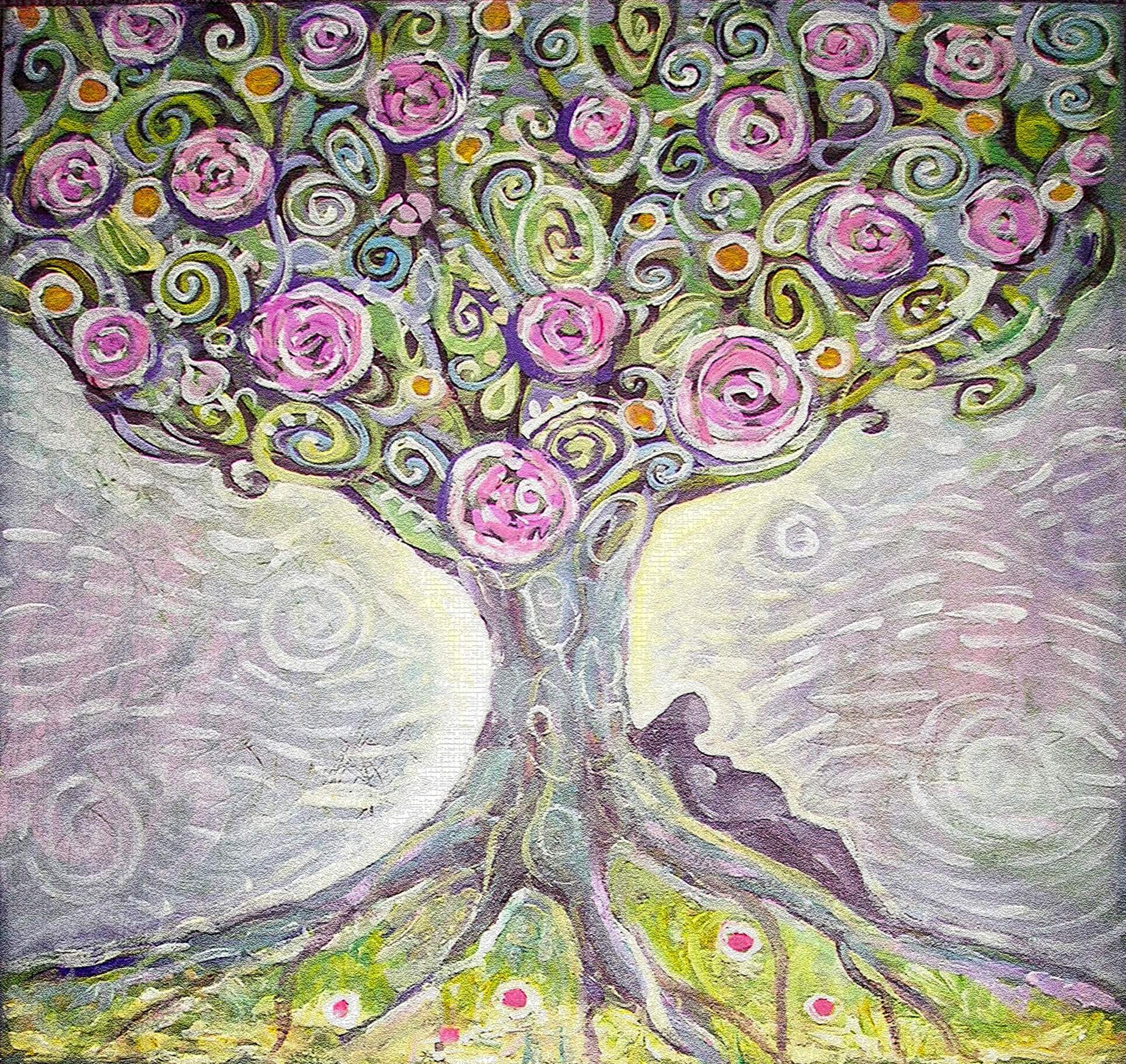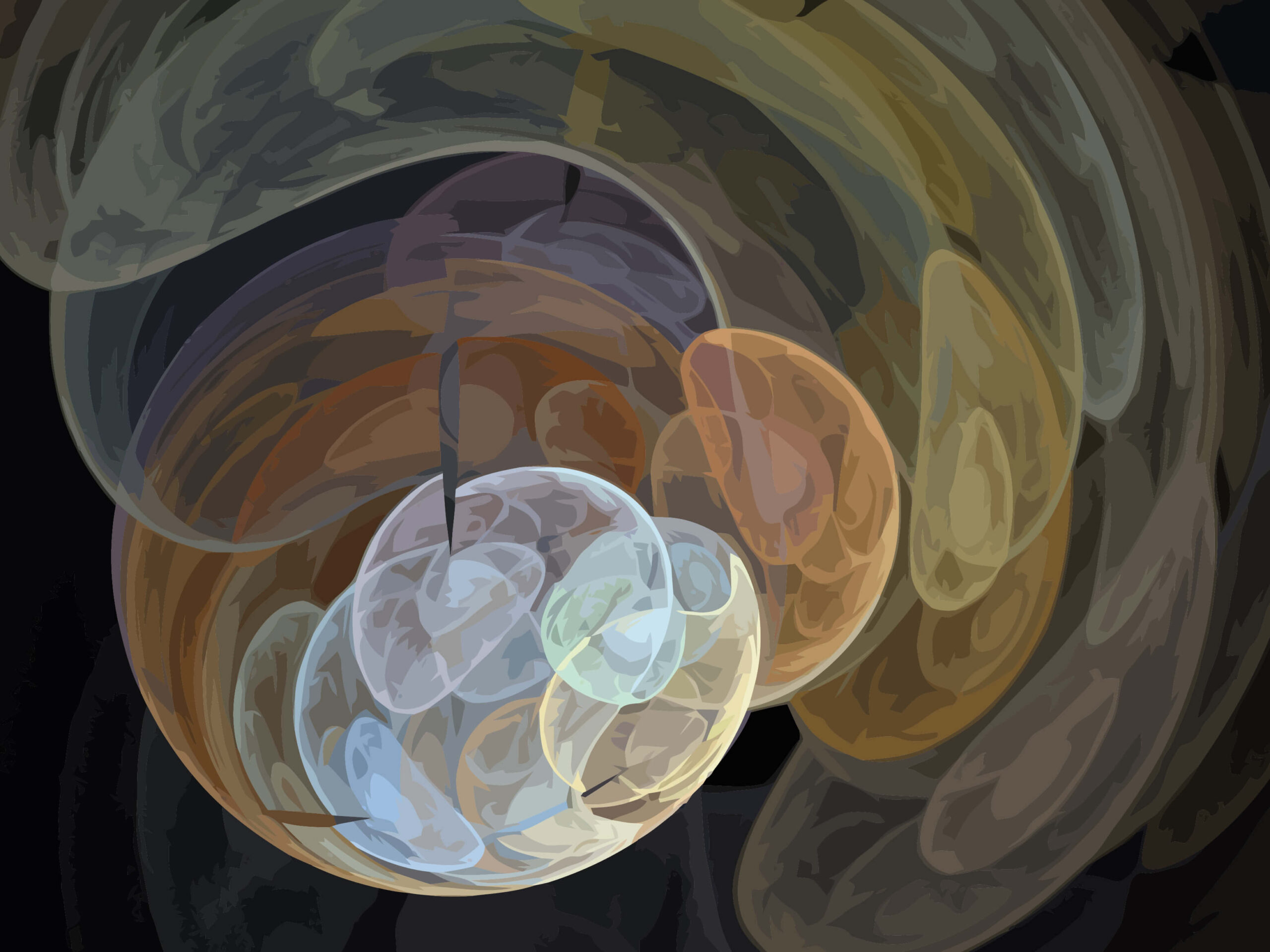Heart and Gall Bladder Qi Deficiency
‘The timid person is frightened before a danger, a coward during the time, and a courageous person afterward’
Johann Paul Friedrich Richter
ABSTRACT
Heart and Gall Bladder qi deficiency pattern is one of the various causes of insomnia and it often occurs in fearful, easily startled and timid patients. It tends to be less understood and recognised by practitioners. This pattern is important in emotional trauma, often brought on by trauma in the womb or in childhood. This paper examines the importance and complexity of this pattern and it examines the various aspects of fear in relation to the Heart and Gall Bladder channels and the various channel pairing patterns involved. It lists the diagnostic signs, physical and emotional symptoms and it gives treatment suggestions, including acupuncture, ear needling, Chinese herbs and affirmations.
INTRODUCTION
Most texts do not offer much explanation or description of likely pathomechanisms of Heart and Gall Bladder qi deficiency patterns. In The Clinical Handbook of Internal Medicine Vol. 3, the authors assert that this condition is likely to be an acquired personality trait which might be brought on by trauma in the womb or in childhood.1 Dr Hammer, in Chinese Pulse Diagnosis, describes the pattern based on the midday/midnight channel clock connection 2 which provides a partial explanation. However, clinicians are often looking for more.
The following paragraphs examine various aspects of fear, the underlying deficiency patterns, how they relate in TCM to the Heart and Gall Bladder channels, and the various channel pairing patterns involved.
Differentiating Fear
Fright has many shades, from a person reacting to a horror movie, to being scared to speak in front of a group, to jumping at the sight of their shadow. Some people are haunted with a feeling of timidity and are generally skittish; these patients lack the courage to simply participate in life. As illustrated by the quotation above, a timid person does not need a dangerous situation to be afraid.
In the Chinese physiological model, this absence of courage stems from a qi deficiency in the Heart and Gall Bladder. The lack of Heart qi fails to secure the shen and the weakness of the Gall Bladder exacerbates the situation by not keeping the shen upright. The Heart, housing the shen, requires the yang qi from the Gall Bladder to maintain a calm when.
Specifically, the Gall Bladder instils upright yang in the body, including the Heart, to embolden movement through life. If the Gall Bladder is compromised (or inherently deficient), then the patient will lack this boldness and will also startle easily. A kind of vicious cycle can follow in which the shen becomes frightened regularly, thus further weakening the Heart. Additional insight might be gleaned by considering the nature and relationships of the channels associated with the two organs.
Same Moving Channel Pairing
The arm shao yin channel is coupled with the leg shao yang channel via the same moving pivot channel pairing. The same movement pairing originates from the Nei Jing and is an essential part of the Master Tung family lineage system.3 The leg and arm channels are paired by opening, pivoting, or closing, and have a yin-yang paired relationship in addition to the same movement.
The opening moving channels are the tai yin and tai yang. The pivoting channels are the shao yin and shao yang. The channels that have a closing movement are the jue yin and the yang ming. Each of these channels is paired by their movement, their yin or yang paired channel, and by the arm and leg.
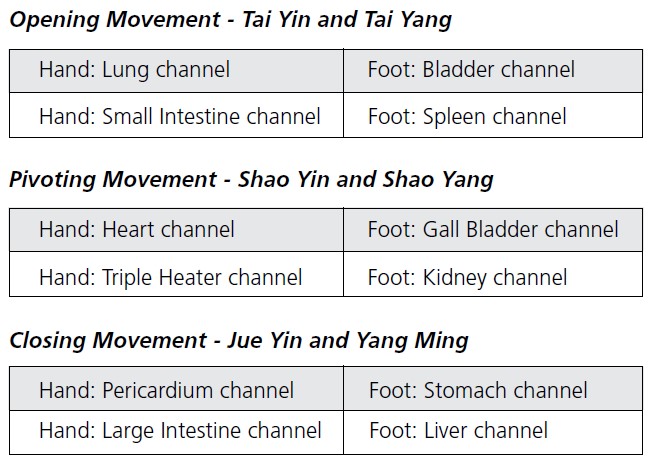
It is through this connection that the Gall Bladder supports the Heart directly. Strong yang qi from the Gall Bladder supplies the Heart with the fortitude to interact with the world with composure and clarity. If the Gall Bladder is weak, its decisionmaking abilities regarding fluid metabolism are compromised and Phlegm is created that mists the Heart. This Phlegm distorts the Heart mirror causing the Heart to overreact. Any damage to either organ will affect the other, resulting in timidity. Because of this relationship, shock can reverberate from one organ to the other. The initial weakness can begin in utero from a trauma experienced by the mother.
Origin of Fright Based on Transference via Shock to the Channel
In utero, the organs are still developing and disturbance to the Heart could transfer to the Gall Bladder or vice versa. Other organs can be disturbed, but in this pattern, it is the Heart/Gall Bladder connection that is affected. Childhood trauma, or trauma experienced as an adult, agitates the Heart and reverberates in the Gall Bladder. The pathogenic action can also stem from the Gall Bladder.
Someone born with a weak Gall Bladder is susceptible to shock that would transmit to the Heart. These traumas weaken both organs and result in qi deficiency.
Shao Yang Providing Qi to Protect the Heart
Strong qi in the Gall Bladder provides courage for making decisions, especially those based on digestion, i.e. what nutrients to digest and how much.4 Processing trauma is part of this ‘digestive’ function as the Gall Bladder must be upright to foster fearlessness and decide what to take in and how to react. The Heart benefits from this qi to maintain a calm shen and to remain settled during a traumatic event. A weak Gall Bladder fails to properly aid digestion resulting in phlegm and the ability to process traumas. Thus, phlegm mists the Heart and traumas are trapped in the body, disrupting the shen, causing timidity.
An additional level of complexity in this pattern arises from the shao yang-jue yin relationship. Upward movement of yang from shao yang supports the Heart-protective function of the Pericardium. In particular, the situation might be further aggravated by a concurrent abdication of the role determining what both enters and exits the Heart. If the regulatory function of the Pericardium is jeopardised, then the Heart is susceptible to injury. Ample qi from the shao yang channel is essential to maintain this stability.
Shao yang also supplies the paired Liver jue yin with courage. In the case of a traumatic event, the Liver responds by maintaining open pathways to the Heart. If the Liver lacks the proper yang in these situations, the lack of clarity described above is further exacerbated. In both cases there is a unique kind of yang deficiency which compromises both Heart shao yin and Liver jue yin pivoting and closing movements.
The shao yang channel is comprised of the Triple Heater (san jiao) and Gall Bladder channels. The Gall Bladder is the yang organ involved in this pattern, not the san jiao. It is the qi from the Gall Bladder that is crucial in this pattern because of its connection with the Heart via the same movement channel pairing (see above).
Yin and Yang Channel Pairing
Another yang organ to discuss in this differentiation is the Small Intestine. The Small Intestine, the yang paired organ of the Heart, supplies the Heart with abundant Blood to stabilise the shen and clear Heat. In anxiety, due to Blood deficiency and Heat, the Small Intestine fails to build Blood to cool and stabilise the shen. Heat and Blood deficient signs would comprise this pattern. The Heart
and Gall Bladder qi deficiency pattern is different in that it involves Cold and Phlegm. The Gall Bladder fails to provide the movement, warmth, and clear fluids required to steady the shen.
Diagnostic Signs to Identify the Heart and Gall Bladder Qi Deficiency Pattern
Observing puffiness at GB 40 qiu xu, thinning or missing outer eyebrows, and paleness on the left side of the tongue with a thick tongue coating (especially on the left side) are some key diagnostic signs that indicate Gall Bladder deficiency. Signs of Heart deficiency include soft sensations palpating the Heart channel, a pale and/or pinched nose tip, a deep, slippery, and thin quality of the pulse in the left distal position 5 and a slightly pale tongue tip with white coating.
Another important determining factor in this diagnosis is how a patient’s sleep is affected. Specifically, they wake due to fright and startle easily when sleeping. This is due to the unsteadiness of the shen. Typically, the patient would report experiencing a shock. The pattern is commonly treated with the Chinese herbal formula Wen Dan Tang (Warm the Gall Bladder decoction).
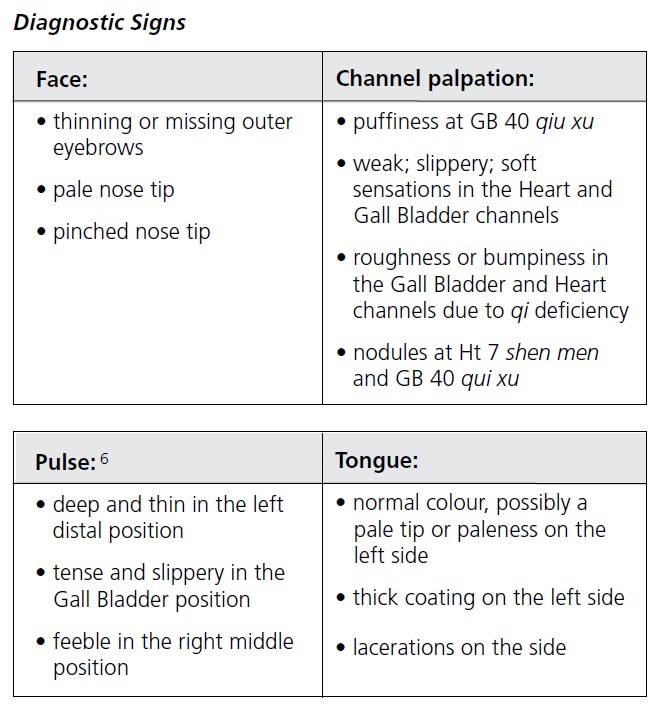
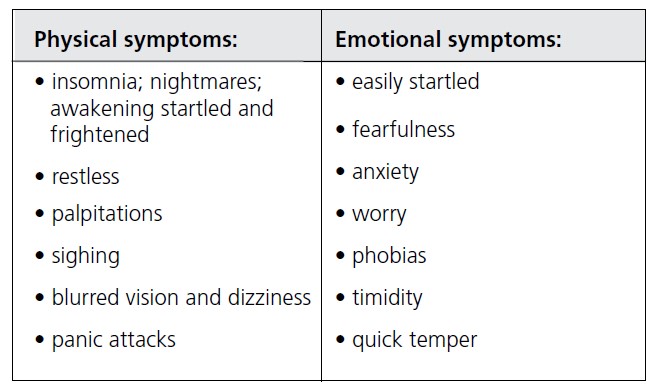
Understanding the Pattern Through Treatment
Dr Wang believes it is important to follow the original version of Wen Dan Tang (Warm the Gall Bladder decoction) encouraged by Sun Si Miao in his book Important Formulas Worth a Thousand Gold Pieces. This approach calls for the increase of sheng jiang (Rhizoma Zingiberis Officinalis) to 12 grams to open and warm the Gall Bladder. *7
Sheng jiang improves circulation and warms the yang. This allows the Gall Bladder to provide yang qi and clear fluids to the Heart to endure a shock.
Acupuncture point prescriptions follow a similar approach. Tonifying GB 40 qiu xu, the source point, increases yuan qi to bolster courage and decision making. The fortified qi travels to the Heart (via their channel connection) to secure the shen.
Resolving Heart and Gall Bladder Qi Deficiency
Benefiting both the Heart and Gall Bladder reduces fright and anxiety and ultimately equips the patient with a solid foundation with which to process future trauma. The pathological signs and symptoms disappear as treatment progresses and the patient will then have the steadfastness to react in and navigate through subsequent stressful events. As Ralph Waldo Emerson encourages, ‘Don’t be too timid or squeamish about your actions. All life is an
experiment. The more experiments you make the better’. Treatment Principle:
Calm the shen, strengthen the Heart, benefit and warm the Gall Bladder, benefit the hun, restore the upright position of the Gall Bladder
Acupuncture:
• Ht 7 shen men and GB 40 qiu xu
• P 6 nei guan and GB 39 xuan zhong
• Bl 15 xin shu and Bl 19 dan shu
• Auricular: shen men, Heart, Gall Bladder, sympathetic
Herbal Formula:
Wen Dan Tang (Warm the Gall Bladder decoction) 8
Note: use the classical dose of 12g for sheng jiang (Rhizoma Zingiberis Officinalis)
Affirmations:
Affirmations are positive mental thought patterns that can have a powerful healing effect. They harmonise beautifully with acupuncture treatment and counteract possible subconscious negative thought patterns. They can be practised by the patient in-between treatment sessions.
‘I am calm and courageous. I make wonderful decisions and I am at peace. I am safe and protected’.
CONCLUSION
The pathomechanisms of the Heart and Gall Bladder qi deficiency pattern are often given little explanation in textbooks. This pattern has a relationship with timidity and fear and is recognised as one of the causes of insomnia. Trauma in utero, in childhood and later in life tends to agitate the Heart and reverberate in the Gall Bladder.
This paper takes a closer look at both Heart qi and Blood deficiency and Gall Bladder yang qi deficiency, the various pathways by which they are connected and the organs with whom they are coupled. Weak Heart qi and Blood do not
secure the shen. Weak Gall Bladder yang qi does not keep the shen upright and allows Phlegm to accumulate and mist the Heart, which results in fear and timidity. A frightened when weakens the Heart and the situation becomes a vicious cycle. The treatment with acupuncture, herbal medicine (Wen Dan
Tang) and affirmations aims to benefit both the Heart and the Gall Bladder, which reduces fright and anxiety and ultimately equips the patient with a solid foundation with which to process future trauma.
Acknowledgements:
Thank you to Dr Friedrich Staebler for helping with modifying the excerpt and for writing the abstract and conclusion. I am grateful to all at Singing Dragon for their ongoing support. Thanks to my partner Tammy Anderson, L.Ac. for all her care and love.
Editor’s Note:
This article is an adapted excerpt from Treating Emotional Trauma with Chinese Medicine by CT Holman, published by Singing Dragon, 2018.
TEXT REFERENCES
1 Maclean, W., and Lyttleton, J. (2010). Clinical Handbook of Internal Medicine, Vol. 3. Sydney: University of Western Sydney. p. 909.
2 Hammer, L. (2001). Chinese Pulse Diagnosis, Revised Edition. Seattle: Eastland Press. p. 562.
3 Young, W. C. (2005). Tung’s Acupuncture. Taipei: Chin-Yuan Book Store. p. 34.
4 Wang, J. Y., and Robertson, J. (2008). Applied Channel Theory in Chinese Medicine. p. 234.
5 Hammer, L. (2001). Chinese Pulse Diagnosis, Revised Edition. Seattle: Eastland Press. p. 404.
6 Hammer, L. (2001). Chinese Pulse Diagnosis, Revised Edition. Seattle: Eastland Press. p. 563.
7 Wang, J. Y., and Robertson, J. (2008). Applied Channel Theory in Chinese Medicine. p. 234.
8 Chen, J., and Chen, T. (2009). Chinese Herbal Formulas and Applications. City of Industry, CA: Art of Medicine Press. pp. 213-14.
Note
This article has been first published by The European Journal of Oriental Medicine.

CT Holman, M.S., L.Ac.
CT Holman, a clinician with over 20 years of practice, teaches internationally and authored two textbooks, Treating Emotional Trauma with Chinese Medicine and Shamanism in Chinese Medicine. CT trained in China three times, operates a busy general family practice in the USA, teaches at the Oregon College of Chinese Medicine for its doctoral program, is the Director of Development for the Lotus Institute of Lillian Bridges, conducts a mentoring program, and has video courses available here below and on his website: www.redwoodspring.com.








